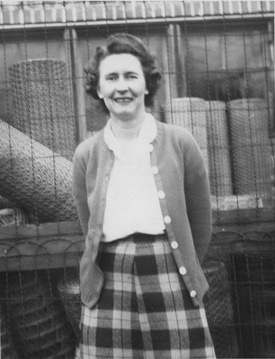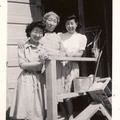Esther Short Boyd was working as usual at the R.R. Short Hardware store in Wapato when a man walked in and identified himself as president of one of the local Granges, a national fraternal association for farmers.
“You went to the Tolan Hearing,” he said. That’s correct, she replied. “Then we can’t trade with you,” he added, reflecting the anti-Japanese sentiment running high in the wake of Pearl Harbor.
She told him that was his privilege.
“It was my privilege to make my own decisions and do what I considered right,” Boyd recalled years later of the brief exchange in the spring of 1942.
Boyd and Wapato farmer Dan McDonald Sr. had testified in Seattle in March of that year on behalf of Yakima Valley residents of Japanese heritage potentially impacted by Executive Order 9066.
Signed by President Franklin Roosevelt on Feb. 19, 1942, the order forced approximately 120,000 West Coast residents of Japanese ancestry into remote prison camps. The order would eventually include 1,017 from the Valley, who were sent to Heart Mountain Relocation Center near Powell, Wyo.
In testifying at the hearing before the Tolan Committee on March 1, 1942, Boyd and McDonald had hoped to prevent the evacuation of their friends and neighbors.
When members of the Valley’s Japanese community learned in May that they would have to leave in June, they turned to Boyd and McDonald.
Shiz Harada left his new International pickup with Boyd. Mary Sakimura asked Boyd to oversee her grocery store. The Hata family, who had subleased land from McDonald since 1927, put their farm equipment in his care. McDonald stored dozens of personal items of the Wada and Seto families and others in his attic and an outbuilding.
And in watching over the Yakima Buddhist Church in Wapato and its precious altar — dismantled and stored under the stage of the adjoining gymnasium — Boyd and McDonald helped safeguard the heart of a community in the Valley since Japanese immigrants began arriving in the early 1890s.
“Both were highly respected members of the business and farming communities who were later subjected to various forms of insults and violence for their acts of courage and invaluable assistance to the evacuating families,” Kara Matsushita Kondo said of Boyd and McDonald in 1981.
A native of upstate New York whose ancestors were staunch abolitionists, Boyd moved to Washington as a child and was valedictorian of her class at Yakima High School; Boyd graduated from Wapato High School. Both earned bachelor’s degrees, Boyd from the University of Washington and McDonald from Washington State.
Their personal fortitude amid entrenched racism and wartime hysteria is a prominent thread in the rich fabric of Valley history. While neither sought attention or recognition, they told their stories many times, about how they helped their Japanese friends before, during and after imprisonment, and why it mattered.
Considering anti-immigrant sentiment today, it’s a story worth telling again, said McDonald’s grandson Paul McDonald. He noted the response his grandfather always gave when others asked him why he took what often was a lonely stand.
“Because it was the right thing to do,” he said.
‘She was a leader’
“I was touched to hear of your efforts in behalf of the Japanese of our district, but I was even more deeply moved to hear how you understood our position and our hearts at this time of sorrow in the world.”
— Letter to Esther Boyd from Ichiro Nishida, June 24, 1942.
Craig Mendenhall of Yakima first began hearing about his grandmother’s strong support of her friends in the Japanese community when she began taking him to the Yakima Buddhist Church’s annual sukiyaki dinner.
“I went every year,” Mendenhall said. When older church members introduced themselves and learned his name, they often shared stories.
“Oh, you’re Esther’s grandson. Let me tell you about Esther,” they would say.
Mendenhall and another grandchild, Lori Franklin of Yakima, and Boyd’s son-in-law Delmar Pearson, who is 98, described her strong sense of social justice as a family trait.
“Her approach to life, it just kind of ran in the family,” Mendenhall said. “Her family was part of the Underground Railroad. Esther’s mother, Nellie, was just about like Esther.
“She just felt really strongly about discrimination. She didn’t think it was right.”
Esther and Winfield Boyd, an accountant whom she married in 1920, moved to Yakima in 1924 after briefly living in California and Walla Walla, raising two children in a big Colonial Revival house at the intersection of 22nd Avenue and St. Helens Street.
“She didn’t take over the hardware store until her dad died” in the 1930s, her son-in-law said. Along with operating the store named for her father, Ralph, Boyd ran two small ranches in the Lower Valley.
Most women didn’t work outside the home then, Mendenhall said. That alone made Boyd stand out, but her efforts to help those in the Valley’s Japanese community prompted rude comments and more.
“Some people refused to trade with me, but most supported me. For a time we found insulting notes on the front doors in the morning,” Boyd recalled. “I used to be afraid I might find things in shambles when I got to Wapato, but I didn’t.”
Dozens of letters to Boyd — a voluminous correspondent — in the Yakima Valley Museum archives testify to her assistance.
“She was a leader, period,” her son said.
The Boyds sold the hardware store in the mid-1970s. The brick building still stands on the east side of Main Street.
Esther Boyd faced some frightening situations but would not let that stop her.
“It was not easy for me to stand up in that crowded room and speak, but I did,” Boyd once recalled. “In reading my recorded speech in the printed book called ‘National Defense Migration’ (two volumes) which was later sent to me, I am proud of what I said.”
Boyd died Sept. 7, 1988. She and Winfield, who died in 1987, are buried at Terrace Heights Memorial Park.
'Good citizens'
“First may I express my appreciation and thanks for all that you have done for us before and after evacuation. Words cannot express my gratitude for such friendship to us Japanese at times like this.”
— Letter to Dan McDonald from Kazuko Hata, Sept. 17, 1942
In mid-June 1994, Paul McDonald wrote a letter to Yosh Hata in hopes of identifying two women in a photograph that he found in a box on the family’s property on the Yakima Valley Highway.
“There is some Japanese written on the outside of the folder that might help. This photo was in a box of household goods I would like to return to this family. ... This box was in storage at my Grandpa McDonald’s,” McDonald wrote. “Let me know if you or Mrs. Hata have any clues.”
After asking others, Hata wrote back three days later, having identified the sisters in the photo taken April 2, 1932. They were Yoshiko Yonemura Yorita, who lived in Garden Grove, Calif., after World War II; and Nobuko Yonemura Mukainari.
In 1993, McDonald returned a bronze statue of a fisherman, a Seto family heirloom, after learning that Mas Seto lived in the area. Seto was born at Heart Mountain in 1944, and Dan McDonald Sr. had stored the statue in an outbuilding.
Paul and wife Amy moved into the McDonald family home in 1998. Only McDonalds have lived in the Parker Heights landmark since it was finished in 1911, and McDonalds have farmed land there and elsewhere in the Lower Valley for decades.
Dan McDonald Sr. grew up in a time when some organizations such as the Grange and the American Legion strongly supported “alien land laws” that prevented Japanese immigrants from buying and leasing land. After Pearl Harbor, those same groups called for removal of Japanese residents, as did editorials in Toppenish, Wapato and Yakima newspapers.
McDonald moved in many of the same circles as people who agreed with those editorials. But his long friendships with several Japanese families, some of whom he worked alongside and leased land to, prompted his support.
“My contact with the Japanese has proved to me that they are good citizens of the United States,” McDonald testified before the Tolan Committee. “They have very good morals; they are hard-working, thrifty, law-abiding, anxious to contribute to national and community enterprises and to charitable work.”
Paul McDonald learned the extent of his grandfather’s efforts after broadcaster Charles Kurault came to Wapato in 1979 for a story about him and Boyd. The story also went out on NPR.
“I was proud of him for taking a stand and not being afraid of what his friends would say or do,” his grandson said.
Dan McDonald Sr. died on Jan. 31, 1997. He is buried at Tahoma Cemetery in Yakima.
“At the time of Pearl Harbor, public opinion was so hateful toward us and we only had two individuals in the Yakima Valley that had enough conviction to stand up and speak on behalf of our presence here,” Yosh Hata said in a story in the Yakima Herald-Republic after McDonald’s death.
“He had the courage to do what was right,” Hata said.
*This article was originally published on Yakima Herald-Republic on October 11, 2017.
© 2017 Tammy Ayer







